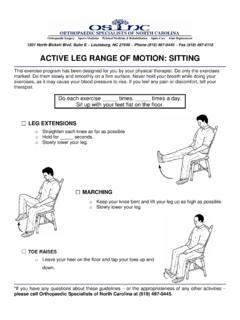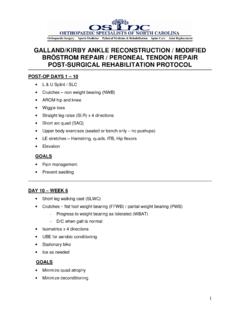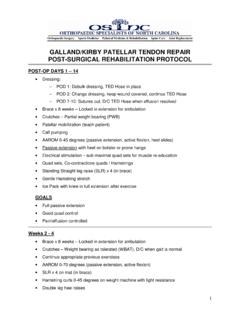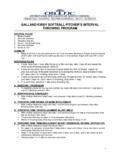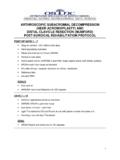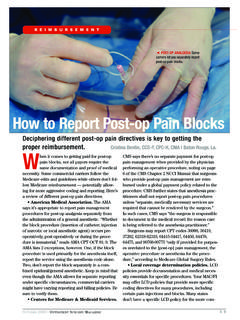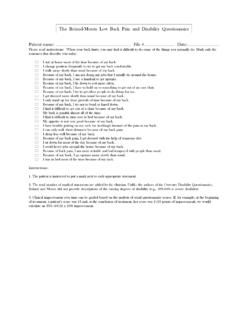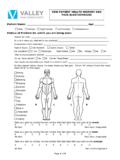Transcription of Back Pain Exercizes - orthoncforms.com
1 Page 1 back pain Exercises Key points Low back pain is very common among adults and is often caused by overuse and muscle strain or injury. Treatment can help you stay as active as possible, and it will help you understand that some continued or repeated back pain is not surprising or Most low back pain can get better if you stay active, avoid positions and activities that may increase or cause back pain , use ice, and take nonprescription pain relievers when you need them. When you no longer have acute pain , you may be ready for gentle strengthening exercises for your stomach, back , and legs, and perhaps for some stretching exercises. Exercise may not only help decrease low back pain , but it may also help you recover faster, prevent reinjury to your back , and reduce the risk of disability from back pain . Exercises to reduce low back pain are not complicated and can be done at home without any special equipment.
2 It's important that you don't let fear of pain keep you from trying gentle activity. You should try to be active soon after noticing pain , and gradually increase your activity level. Too little activity can lead to loss of flexibility, strength, and endurance, and then to more pain . Exercises that may help reduce or prevent low back pain include: Aerobic exercise, to condition your heart and other muscles, maintain health, and speed recovery. Strengthening exercises, focusing on your back , stomach, and leg muscles. Stretching exercises, to keep your muscles and other supporting tissues flexible and less prone to injury. Some exercises can aggravate back pain . If you have low back pain , avoid: Straight leg sit-ups. Bent leg sit-ups or partial sit-ups (curl-ups) when you have acute back pain . Lifting both legs while lying on your back (leg lifts).
3 Lifting heavy weights above the waist (standing military press or bicep curls). Toe touches while standing. Exercise and staying active may relieve low back pain and can help speed your recovery. Stretching and strengthening your stomach, back , and leg muscles helps make them less susceptible to injury that can cause back pain . Strong stomach, back , and leg muscles also better support your spine, reducing pressure on your spinal discs. This may help prevent disc injury. Aerobic exercises-such as walking, swimming, or walking in waist-deep water-also help you maintain a healthy back . Aerobic exercise makes your heart and other muscles use oxygen more efficiently. Muscles that frequently receive oxygen-rich blood stay healthier. Most people who have back pain naturally feel better by doing certain motions.
4 Some feel better sitting (their back and hips are flexed), while others feel better standing ( back and hips are extended). Exercise that moves you toward your more comfortable position is usually more successful in treating your back pain . For example, if you are more comfortable sitting down, exercises that bend you forward-such as partial sit-ups (curl-ups) and knee-to-chest exercises-may help you. Only do exercises that do not increase your symptoms. Try to exercise a little bit every day. Get some type of aerobic exercise, such as walking, every day. Even a couple of minutes will be helpful, and you can gradually increase your time. Choose a couple of stretching and strengthening exercises that you enjoy doing, or vary them from day to day. Stretching and strengthening exercises include: Extension exercises, which stretch tissues along the front of the spine, strengthen the back muscles, and may reduce pain caused by a herniated disc.
5 These are generally a good choice for people whose back pain is eased by standing and walking. Page 2 Press-up back extension Lie on your stomach with your hands under your shoulders. Push with your hands so your shoulders begin to lift off the floor. If it's comfortable, put your elbows on the floor directly under your shoulders so you can rest in this position for several seconds. Alternate arm and leg (bird dog) exercise Do this exercise slowly. Try to keep your body straight at all times, and don't let one hip drop lower than the other. Start on the floor, on your hands and knees. Tighten your stomach muscles. Raise one leg off the floor and hold it straight out behind you. Be careful not to let your hip drop down, because that will twist your trunk. Hold for 5 seconds, then lower your leg and switch to the other leg.
6 Repeat 8 to 12 times on each leg. Over time, work up to holding for 10 to 30 seconds each time. If you feel stable and secure with your leg raised, try raising the opposite arm straight out in front of you at the same time. Flexion exercises, which strengthen stomach and other muscles, and stretch the muscles and ligaments in the back . These are generally a good choice for people whose back pain is eased by sitting down. Knee-to-chest exercise Do not do the knee-to-chest exercise if it causes or increases back or leg pain . Lie on your back with your knees bent and your feet flat on the floor. Bring one knee to your chest, keeping the other foot flat on the floor (or the other leg straight, whichever feels better on your lower back ). Keep your lower back pressed to the floor. Hold for at least 15 to 30 seconds.
7 Relax and lower the knee to the starting position. Repeat with the other leg. Repeat 2 to 4 times with each leg. To get more stretch, put your other leg flat on the floor while pulling your knee to your chest. Curl-ups Page 3 Lie on the floor on your back with your knees bent at a 90-degree angle. Your feet should be flat on the floor, about 12in. from your buttocks. Cross your arms over your chest. Slowly contract your abdominal muscles and raise your shoulder blades off the floor. Keep your head in line with your body-don't press your chin to your chest. Hold this position for 1 or 2 seconds, then slowly lower yourself back down to the floor. Repeat 8 to 12 times. Prone buttocks squeeze This exercise strengthens the buttocks muscles, which support the back and help you lift with your legs. Lie flat on your stomach with your arms at your sides.
8 Slowly tighten your buttocks muscles and hold the position (not your breath) for 5 to 10 seconds. Relax slowly. Repeat 8 to 12 times. You may need to place a small pillow under your stomach for comfort. Pelvic tilts Lie on your back with your knees bent. "Brace" your stomach-tighten your muscles by pulling in and imagining your belly button moving toward your spine. You should feel like your back is pressing to the floor and your hips and pelvis are rocking back . Hold for 10 seconds while breathing smoothly. Repeat 8 to 12 times. Bridging Heel dig bridging exercise works your hamstrings and the muscles around your hip. Do 8 to 12 repetitions. Do not continue with this exercise if it causes pain . Lie on your back with both knees bent and your ankles bent so that only your heels are digging into the floor.
9 At this point, your knees should be bent about 90 degrees. From here, push your heels into the floor, squeeze your buttocks, and lift your hips off the floor until your shoulders, hips, and knees are all in a straight line. Hold briefly, and then slowly lower your hips back down to the floor. Hamstring stretch Lie on your back in a doorway, with one leg through the open door. Slide your leg up the wall to straighten your knee. You should feel a gentle stretch down the back of your leg. Hold the stretch for at least 15 to 30 seconds. o Do not arch your back . Page 4 o Do not bend either knee. o Keep one heel touching the floor and the other heel touching the wall. Do not point your toes. Repeat with your other leg. Do 2 to 4 times for each leg. If you do not have a place to do this exercise in a doorway, there is another way to do it: Lie on your back and bend the knee of the leg you want to stretch.
10 Loop a towel under the ball and toes of that foot, and hold the ends of the towel in your hands. Straighten your knee and slowly pull back on the towel. You should feel a gentle stretch down the back of your leg. Hold the stretch for at least 15 to 30 seconds. Repeat with your other leg. Do 2 to 4 times for each leg. Hip flexor stretch Kneel on the floor with one knee bent and one leg behind you. Position your forward knee over your foot. Keep your other knee touching the floor. Slowly push your hips forward until you feel the stretch in the upper thigh of your rear leg. Hold the stretch for at least 15 to 30 seconds. Repeat with your other leg. Do 2 to 4 times on each side. Wall sit The wall sit exercise strengthens your back , trunk, and thigh muscles, helping you maintain a healthy lower back . 1. Stand with your back 10in.
